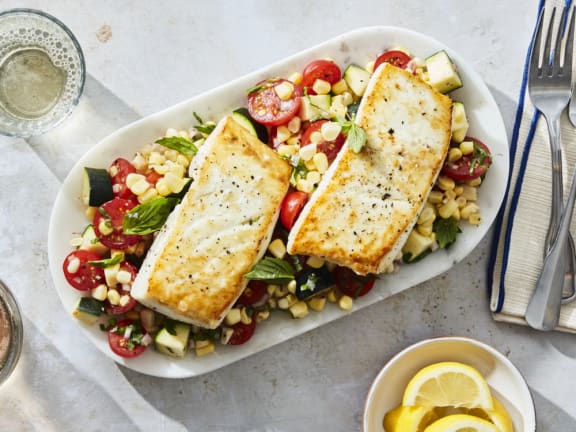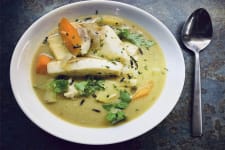Pacific halibut is a large species of flatfish that can be caught off the west coast of the United States, as far north as Alaska. This coveted species is one of the more expensive varieties of white fish on the market since fisheries are tightly-regulated to ensure sustainable harvests for years to come.
Pacific halibut fillets are lean with a mild, subtly sweet flavor. It’s a coveted species of white fish that can be enjoyed using a variety of cooking methods, delicious to enjoy with simple seasonings but hearty enough to stand up to flavorful sauces.
What Does Pacific Halibut Taste Like?
Pacific halibut has a mild, subtly sweet flavor. This delicate sweetness, combined with its hearty texture, is why Pacific halibut is so special.
Pacific halibut is often used interchangeably with Pacific cod. Deciding which variety of white fish to use is less a question of whether Pacific halibut or Pacific cod tastes better and more about the preparation, since they both have distinct textures. Pacific halibut, for instance, is better than Pacific cod when grilling or searing, but other dishes like chowders or fish tacos can be made with either fish since they’re both mild and flaky.
What Does Pacific Halibut Look Like?
Pacific halibut is a very large species of flatfish. Halibut weigh about 30 pounds on average, when they're harvested. However, this species can grow so large — up to 8 feet in length — that it's sometimes compared to a barn door.
Being a flatfish, Pacific halibut has both its eyes on the same side of its head, allowing it to look up from the seafloor. Its skin has a grey/brown appearance that blends in with the sandy bottoms of its habitat.
Where Does Pacific Halibut Come From?
In the U.S., Pacific halibut is commercially harvested as far south as California and as far north as Alaska. Homer, Alaska, is known as the Halibut Fishing Capital of the World.
Pacific halibut is oftentimes harvested with longline fishing. A fishing line (up to a mile long) is affixed with baited gangions that rest on the seafloor, where this species spends much of its time.
Is Pacific Halibut Sustainable?
There are two species of halibut available on the market: Pacific halibut and Atlantic halibut. Wild-caught pacific halibut is the sustainable seafood option, when it’s harvested from Alaskan fisheries.
In contrast, east coast fisheries have overfished Atlantic halibut. Currently, Atlantic halibut populations are recovering from decades of unsustainable fishery management. If you’re shopping for a sustainable halibut option, make sure you choose Pacific halibut from Alaska.
Pacific Halibut Nutrition
Pacific halibut is low in fat and high in protein. It’s also a great source of vitamin D and a good source of potassium. It may contain a moderate amount of mercury that certain at-risk populations will want to consider. The NRDC recommends that pregnant women, nursing mothers, women planning to become pregnant, and young children moderate their consumption to reduce the risk of mercury exposure.
Nutrition per 6-ounce serving:
-
Calories: 130 calories
-
Fat: 1 gram
-
Protein: 30 grams
-
Vitamin D: 9 micrograms, or 45% RDI
-
Potassium: 750 milligrams, or 15% RDI
How to Cook Pacific Halibut
Here are some step-by-step guides for how to cook Pacific halibut, plus some easy recipe ideas:
Where to Buy the Best Pacific Halibut
Stock your kitchen with sustainably harvested Pacific halibut by sourcing your seafood online from Wild Alaskan Company. You’ll get high-quality, wild-caught seafood delivered straight to your doorstep. Choose your seafood subscription box today.






